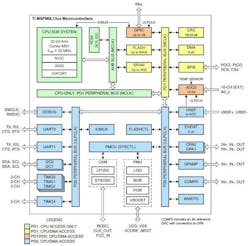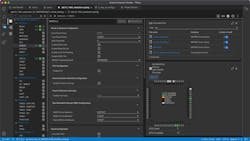Members can download this article in PDF format.
Embedded technology promises to transform smart homes, cities, factories, and vehicles—helping to improve energy efficiency and make electronics products more environmentally sustainable. Sameer Wasson, vice president and business unit manager of Texas Instruments’ processor business, envisions electronics integrated into our surroundings to facilitate immersive interaction, with autonomous robots performing tasks around the home and factory and making technology more accessible.
“To make this future a reality, embedded processors need to evolve,” wrote Wasson. “They need to deliver more intelligence while consuming less power. And, they need to be affordable, feature more integrated components, and be supported by intuitive, embedded software and tools.”
Embedded Processing Trends
Wasson identifies three trends in processor evolution. First, the processors are integrating more sensing capabilities. Second, they’re becoming capable of adding artificial intelligence (AI) to every system. And third, they’re increasingly being supported by easy-to-use development ecosystems that enable faster times to market.
The additional sensor capabilities will allow embedded systems to gather more data and put it to innovative use. For example, in the smart city, energy-management systems will monitor and control energy usage to reduce waste and control costs, and intelligent public safety systems will help detect and respond to emergencies.
In the smart home, ecosystems of connected devices will boost efficiency, safety, and comfort to add quality and convenience to consumers’ lives. And finally, embedded intelligence combined with real-time data will improve the sustainability and reliability of distributed renewable-energy sources in the electric-grid infrastructure.
The need to integrate sensing and embedded intelligence has guided TI in its development of a new portfolio of microcontrollers—the scalable Arm Cortex-M0+ microcontrollers, which enable you to reduce costs at both the component and system level without compromising performance. The devices integrate enhanced analog capabilities to streamline sensing-circuit development without the need for additional components.
One member of the portfolio (Fig. 1) has sufficient integration to enable a new lineup of chamberless smoke detectors that reliably detect smoke faster and to run for more than 10 years on a 9-V battery.
As for AI, intelligence at the edge will augment everything from smart security cameras monitoring homes and businesses to autonomous robots transforming assembly lines. For example, smart cameras throughout a factory can constantly monitor equipment to predict faults and shut down the equipment quickly before a catastrophic failure, avoiding the delays inherent in sending data to the cloud for processing. Devices such as TI’s AM6xA vision processors provide the processing power and efficiency necessary to bring the necessary intelligence within the factory environment.
Time-to-market will be critical to companies striving to bring AI to the smart home, factory, and city. Easy-to-use processors coupled with capable development ecosystems will allow engineers to spend more time innovating and differentiating their products and less time wrestling with complex proprietary design tools.
“That is why I am committed to strengthening our company’s use of industry-standard and open-source software, community development platforms, and unified software development environments,” said Wasson. He adds that TI offers the design resources that allow for engineers to leverage the knowledge and experience of experts so that they can design efficiently and bring products to market rapidly.
Simplifying Embedded Development
TI design resources that help facilitate embedded development center around the TI Developer Zone, a comprehensive collection of easy-to-use hardware and software tools that helps engineers quickly turn ideas into schematics. They can plug in their target boards and find themselves coding on the desktop or in the cloud in minutes.
According to John Stevenson, TI’s development tools product manager, the TI Developer Zone is an online environment dedicated to helping users of TI’s processors, microcontrollers, wireless connectivity devices, and radar sensors. He said, “Whether you are just starting evaluation or ready for more significant work, the TI Developer Zone is the place to go to bring your idea to the next level.”
The TI Developer Zone combines advanced development tools with examples and training materials specific to the particular TI device or board chosen by an engineer, eliminating the need to wade through irrelevant content. The TI Developer Zone lets you get started working in the cloud, where you can access cloud-based tools through a browser, avoiding the need to download and install software. One such tool is TI’s Code Composer Studio Cloud, which presents a simple user interface accessible from anywhere.
In addition, a system-configuration tool called SysConfig (Fig. 2) enables you to configure system power, flash controllers, interrupts, clock trees, and other functions. It automatically detects and resolves resource conflicts to simplify hardware and software setup. You simply select peripherals, modes, and settings, and SysConfig generates the necessary configuration code.
Another cloud-based tool is Edge AI Studio, which allows you to use your own data to retrain any of the hundreds of optimized pretrained models in the TI Model Zoo to create a custom model. You can also leverage open-source software such as the YOLO (You Only Look Once) single-pass object-recognition algorithm.
Edge AI Studio will provide data on latency, DDR bandwidth, accuracy, and other benchmarks. The cloud-based tool makes it unnecessary to devote local computing power to the model-development process. The platform targets applications such as machine vision, factory and warehouse automation, and smart agriculture.
Resource Explorer is another key element of the TI Developer Zone. It includes 20 software development kits (SDKs) and more than 10,000 sample projects. You can drill down within each SDK to inspect source code and learn how to use a specific peripheral or software stack. Resource Explorer also includes more than 800 training modules to help you get up to speed.
Conclusion
Efficient, environmentally sustainable products require microcontrollers that can apply AI to process large amounts of sensor data. An extensive easy-to-use design ecosystem helps bring these products to market quickly. The TI Developer Zone combines hardware and software tools as well as project examples and training materials that will help accelerate the design process.


